![]()
![]()
![]()
Use LEFT and RIGHT arrow keys to navigate between flashcards;
Use UP and DOWN arrow keys to flip the card;
H to show hint;
A reads text to speech;
15 Cards in this Set
- Front
- Back
|
During physiologic calibrations, the EEG and EOG channels present a high amplitude, very slow wave artifact. What is the most appropriate course of action? |
Take steps to correct sweat artifact including cooling the patient and replacing the ground lead. |
|
|
During the night, the tech notices that the C3 channel appears slightly darker than the other EEG channels. What should she do first? |
Run an impedance check. If the impedance in this channel is higher than 5k Ohms, the electrode should be reapplied or replaced. |
|
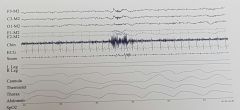
What artifact is seen at the 15-second mark of the epoch? |
Snore Artifact |
|
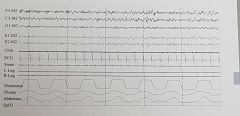
What artifact is shown in the airflow channel? |
Pen Blocking |
|
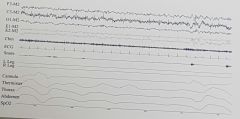
What artifact is shown in the C3 channel? |
High Impedances or 60Hz Artifact |
|
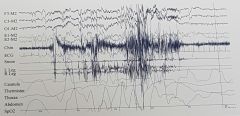
What artifact is shown below? |
Movement Artifact |
|
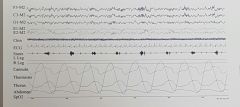
What is wrong with the thermister channel? |
The gain or sensitivity setting is too high, causing the signal to intrude into other channels. |
|
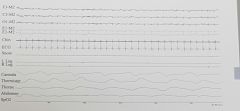
What artifact is seen in the Chin EMG channel? |
EKG Artifact |
|
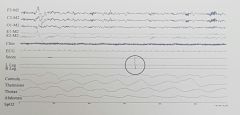
What artifact is circled? |
Electrode Popping |
|
|
The airflow channel squares rather than rounds at the peaks. What should the technician do? |
Adjust the sensitivity setting to correct the pen blocking artifact. |
|
|
When attempting to correct an artifact, the technician notices that the artifact appears in multiple channels. What should he do next? |
Check to see if there is a common reference between the affected channels. |
|
|
Shortly after the patient wakes up, all signals on the PSG show a high frequency, very high amplitude artifact obscuring all the tracings. What is the most appropriate course of action? |
Wait for the patient to stop moving, as this is most likely movement artifact. After movement has stopped, determine if any leads have detached and reapply if necessary. |
|
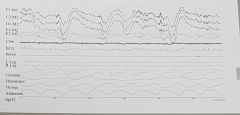
What artifact is seen in the EEG channels? |
Sweat Artifact |
|
|
During the night, the patient awakens and kicks off one of the leg EMG leads. What should the technician do? |
Enter the patient room and replace the lead. |
|
|
The EEG and EOG channels present an intermittent single fast wave approximately every second. What is the most appropriate course of action? |
Take steps to correct EKG artifact starting with moving M1 and M2 to the earlobes. |

